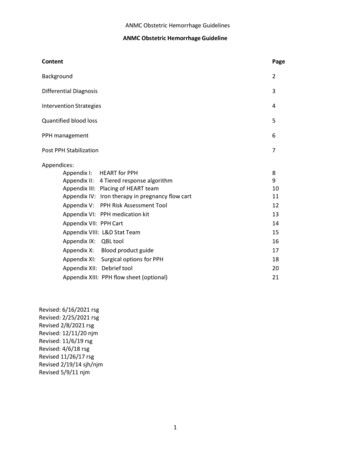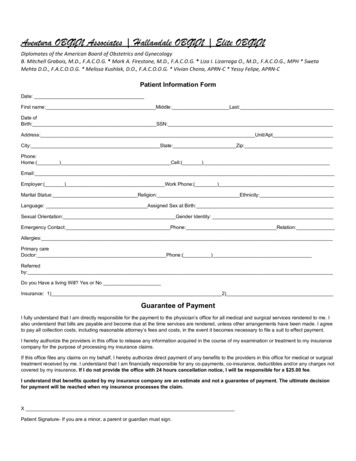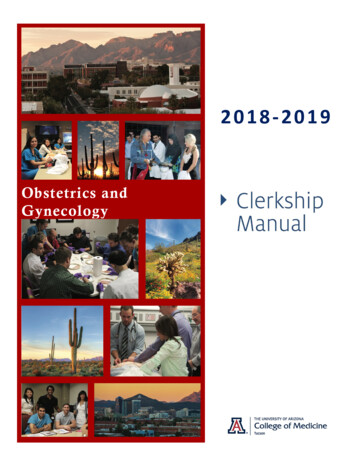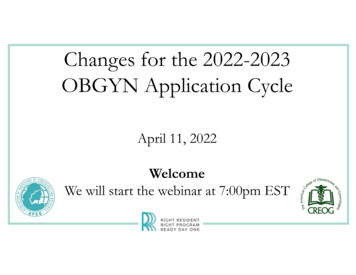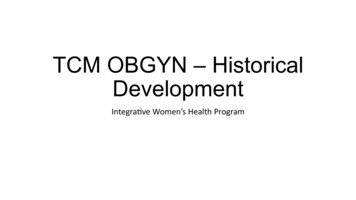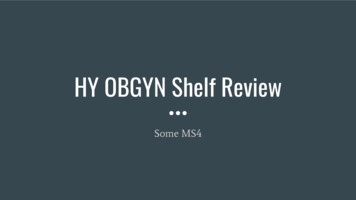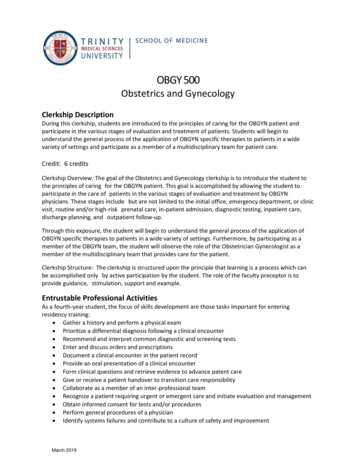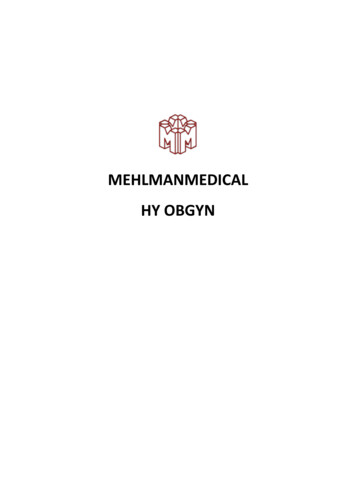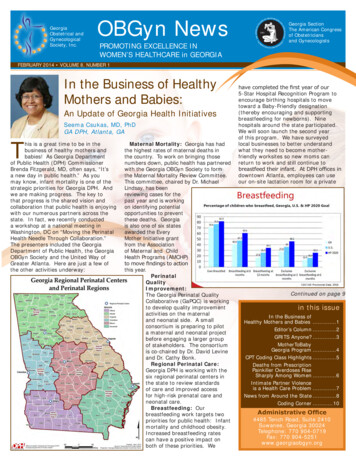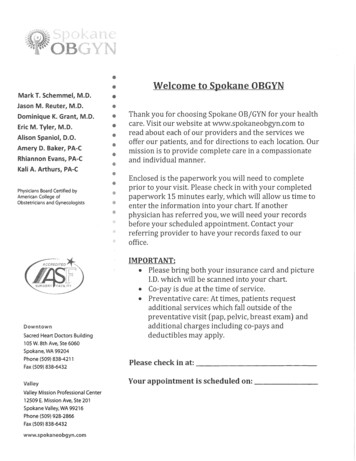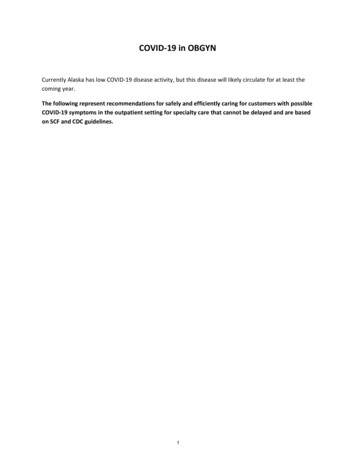
Transcription
COVID-19 in OBGYNCurrently Alaska has low COVID-19 disease activity, but this disease will likely circulate for at least thecoming year.The following represent recommendations for safely and efficiently caring for customers with possibleCOVID-19 symptoms in the outpatient setting for specialty care that cannot be delayed and are basedon SCF and CDC guidelines.1
Table of Contents1)2)3)4)5)6)7)COVID-19 in Primary Care Training Module . 3COVID-19 Screening and Response- OBGYN . . . . .7OBGYN Roles & Responsibilities for Suspected COVID-19/COVID Positive Care . .8Specialty Clinics COVID-19 Front Door Screening and Response . 9COVID Front Desk Screening Checklist.10COVID-19 In-Clinic Response.11ACOG Covid-19 Triage Algorithm Adapted.128) COVID-19 Screening and Response (PCC).132
COVID-19 in Primary Care Training ModuleSafely evaluating customers with COVID-19 symptoms in your clinicBelow are steps that all primary care clinics should take prior to seeing COVID-19 symptomaticcustomers Clinic preparationo Designate rooms COVID-19 customer exam rooms Determine how many rooms are needed per clinic/floor Consider location in clinic – low traffic Get rid of non-cleanable things in these rooms Have pulse ox, stethoscopes, etc, that stay in these rooms Donning and doffing rooms Locate near COVID-19 exam rooms Consider larger rooms, mirror, no badge access needed One room for East/West clinics might be sufficiento Equipment and supplies Dedicated equipment in COVID-19 rooms that can be cleaned, as above Appropriate and adequate cleaning supplies for terminal room cleans Ensure adequate PPE stocked in donning/doffing rooms Ensure proper training and PPE practice Ensure respirator FIT testing availableo Stay current on PPE recommendations Review crash cart, code response Respirators needed if aerosols (e.g., compressions, nebs)Triage and scheduling –follow updated flowcharts and guidelineso Every customer with COVID-19 symptoms gets triaged by RNCM and/or provider If no COVID-19 symptoms, standard care and precautions applyo Longer appointment blocks for COVID-19 symptoms Extra time for PPE, terminal clean, different workflowsDuring the visit Current guidelines are everyone is masked all the timeo Even asymptomatic customers and staffMinimize unnecessary close contact with customer with COVID-19 symptomso Try to minimize or avoid time in waiting room for customer Flag visits ahead of time, immediately room, call from caro Provider to get initial history remotely (by phone, at exam room door)o Can one provider in PPE get vitals, do exam, and get specimens?3
Less PPE burn Fewer people in close contact with customerWhile in the room, provider can call CMA to document vitals, request assistanceo Laptops should not go into the roomStay up to date on COVID-19 testing guidanceo For example, observed self-nasal swabs may be an easier, effective optionAfter the exam, the provider should not take anything out of the roomo No specimens, no paperwork, no gowns or gloves, no unused supplieso CMA to escort the customer out when everything doneAfter the visit If a customer needs medication from pharmacy, have them delivered to the roomo Stay up to date with latest workflowsIf a customer needs radiology, CMA to call ahead to coordinateo Stay up to date with radiology workflowsEnsure proper terminal room clean procedures are followedo Ensure all CMAs trained on procedureo Ensure adequate suppliesFAQDo I have to do everything listed above just to see a customer with COVID-19 symptoms in clinic?The basic goal is to identify customers with COVID-19 symptoms, mask and room them with minimalcontact with others, examine them safely using current PPE recommendations, and ensure the roomsare properly cleaned.Many of the recommendations and techniques above might help reduce risk even further, preserve PPE,and streamline care, but ultimately each clinic should develop and use a process they are comfortablewith.Visit the CDC resource below for more information.What level of PPE should I use for customers with COVID-19 symptoms?Current recommendations are that anyone who will be providing care for (i.e. touching) a customer withCOVID-19 symptoms in an outpatient setting should have: GownGlovesSurgical maskFace shield/eye protection.4
There are lists of aerosol generating procedures (e.g., nebulizers, CPR compressions), if any areconducted in clinic, respirators (N95/PAPR) should be used.Does every customer with any COVID-19 symptoms require ‘full’ PPE?That is the current recommendation. Even mild symptoms should involve the use of the above list.Providers should also use clinical judgement (recent negative COVID-19 test, duration of symptoms,alternative explanations for symptoms, community disease activity) to determine appropriate PPE foreach visit.What about customers with COVID-19 symptoms who recently tested negative for COVID-19?False negative results do occur, and this should be taken into consideration. Providers should use clinicalas above to determine appropriate PPE for each visit.What PPE should I wear for customers with no COVID-19 symptoms?Current recommendations are that if you are coming into contact with a customer with no COVID-19symptoms, you can consider PPE in addition to a surgical mask (for example, if there is a lot ofcommunity transmission), but it is not necessary.Surgical mask alone will often be sufficient.When can a customer previously positive with COVID-19 be seen in clinic?A customer can be seen in clinic at any time during their illness. Ideally, if they are considered stillpotentially infectious, in-person clinic visits should be avoided. If an in-person visit is deemed necessaryduring this time, the precautions outlined above should be followed.To be considered non-infectious after a COVID-19 diagnosis, current recommendations are that they areat least 10 days from illness onset, and at least 3 days from any COVID-19 symptoms. Note that ageusiaand anosmia can last for a long time and should not be considered persistent symptoms but sequelae.Repeat testing is not required but can be considered but note that COVID-19 PCR tests can remainpositive after infectiousness (i.e. non-viable virus detected).Does everyone really need to be masked all the time?That is the current recommendation. Providers can wear a cloth mask (not PPE) in between customers,in the ICT area, and switch to procedure mask (PPE) for the evaluation. All customers, with or withoutsymptoms, should be masked. All staff in a building where clinical activity is happening should bemasked when close to, or potentially close to, other people.Follow current recommendations closely, as they often change.How can I better prepare my team and clinic for this?5
The ‘respiratory clinic’ is still functioning through June 12th. Providers and staff can coordinate a visitthere to observe or work a shift while it is still open to get familiar with the workflow for customerspresenting with COVID-19 symptoms.Designate a ‘lead’ (medical director) for each clinic/floor to help get things in place, rooms prepared,PPE stocked, education rolled out.Additionally, many staff who worked in the ‘respiratory clinic’ will be going back to their home clinics towork and will be a good resource.Educational videos have been created and are available by clicking this LINK.Ultimately, care of a customer with COVID-19 symptoms can be about as streamlined and safe as anyvisit for any customer with some basic preparation and familiarity with the process, outlined rycare/Covid19/default.aspx6
COVID‐19 Screening and Response‐ OBGYNAppointment SchedulingCheck‐In at Front DeskCustomer Owner(CO)needs in‐clinicappointmentAsk CO questions on thePhone Screening ChecklistRemind CO:“We recommend thatyou come to yourappointment alonefor the safety of yourfamily, and to preventthe spread ofcoronavirus.”No to allCustomer Ownerpresents forappointmentEnsure frontdoor screeningcomplete for COand any visitorsConfirmappointmentCO Screening processYes to anyAdminister ClinicScreening checklistLow suspicion for COVID‐19Propose 24 hr test toOutpt Consultant(OPC) and cancelappt. Forward noteto OPC to signTransfer to RN:RN documents andcontacts OutpatientConsultant for planof careNo to allCheck In CO andHand checklistto CMAYes to any1. Write down CO Nameand chart number2. Instruct CO to use handgel, put on mask, & wait inlobby3. Notify CMA ASAPEnsure CO gets testresultRN confirms orreschedules appointmentbased on plan of careReschedule appointmentwhen test is negativeAny questions about rescheduling, ask Outpatient ConsultantAssess pregnant or postpartum CO for flu and refer to flu algorithm ifnecessary1. CO is placed in isolation room2. Care team develops plan of care3. Proceed to visit with PUI/COVIDprecautions or reschedule per plan of care
OBGYN Roles & Responsibilities for Suspected COVID/COVID Specialty OBGYN Care7.29.20Screening StaffFront DeskCMARNCMCO enters buildingEnsures CO hasan appointmentand dons a maskNotifies CMA toroom the COASAPChecks CO inEscorts CO toisolation room, tellsCO “your Provider willcall you on this phoneshortly”, closes doorNotifies Provider/RNCM that CO isroomed, withexam roomnumberCoordinates withProvider and teamIs Provideravailable?NoEnsures donning/doffing room openChaperone if pelvicexam or procedureindicated w/ PPECommunicateswith CO ASAP bytelephoneDirects team toprepare PPE ifwarrantedBuilds care plan,completesCOVID-19 testingif warrantedTriage hospital vs.homecareIf home, reviewprecautionsYesProviderCommunicateswith CO ASAP bytelephoneCompletes exam& evaluation withPPE if warranted
Specialty Clinics COVID‐19 Front Door Screening and Response“Right now we are limiting people’s riskof exposure by only admitting customerswith a scheduled appointment. Pleasecome back when you have a scheduledappointment.”Customer Owner enters clinical buildingIs CO here for an appointmentor seeking immediate care?NoScreening staff directs COs not here for anappointment to come back when CO has ascheduled appointment.NoCustomer proceeds to their appointmentYesFront Desk/SchedulersScreening staff asks CO to:1) Sanitize hands2) Put on maskDoes CO has a fever,cough, shortness ofbreath, cold symptoms,new onset diarrhea, acutemuscle aches, acute loss ofsmell/taste?YesInstruct the CO to contact their PCP or ifthey are not empaneled, contact InternalMedicine x1500“Once you have been cleared by yourPCP, please call back to schedule yourappointment”Rev: 06.03.20
COVID-19 OBGYN Front Desk Screening Checklist*Use this checklist when COs arrive IN CLINIC for their appointment. Screen all visitors as well. Anyone whoscreens positive should not enter the clinic area until discussed with the team*STEP 1: Ensure they are masked.STEP 2: Ask the following additional questions:In the past 14 days have you had any of the following symptoms:FeverCoughNew onset shortness of breath/difficultybreathingSymptoms of common coldDiminished sense of smell/tasteNew onset diarrheaChillsFatigueHeadacheMuscle/joint achesRunny noseSore throat or sputum productionNoneIn the past 14 days have you or a household member traveled outside the state of Alaska?YesNoHave you had known close contact with someone who tested positive for COVID19?YesNoDo you have a test pending for COVID19?Yes ***Check here if the test was ordered as a pre-op or pre-admission. Treat this as a No***NoIF a CO has a positive screen at the door they will be brought over by the door screener and should be attendedto immediately. Ensure mask is on and 6 feet of distancing is maintained.Complete Step 2 for more detailed screening and follow flow to contact the care team.-If NO for all, Proceed with appointment. Hand completed checklists to CMA.-If a visitor and YES to any, instruct use of alcohol hand gel, don a mask, follow social distancing, andwait in the lobby.-If yes and a CO, Follow Flow to contact the appropriate person.
COVID‐19 IN CLINIC RESPONSEPurpose: Details the steps for Providers or Nurse Case Managers to complete when engaging with suspected COVID‐19 customers physically in clinic.Customer Owner (CO) disclosesin clinic that they have possibleCOVID‐19 symptomsProvider to excuse themselvesfrom the room. Provider to confirmhistory by phone with CO. Dials 6digit exam room phone extension.*Recently developed any one of the following: Fever/Chills Cold symptoms (runny nose, sore throat, cough,headache) Difficulty breathing Diarrhea Fatigue or body aches Changes in sense of taste/smell Travel outside of Alaska within 14 days Exposure to anyone with known COVID‐19 caseInquire if CO has any onesymptom to the leftNoYes*Provider determines testing forCOVID‐19 warranted?NoComplete office visit and advise CO ofcare plan as appropriateYes**Wearing appropriate personalprotective equipment (PPE), assessclinical statusConfirm Patient Under Investigation(PUI) and complete testing***.Advise CO of care plan as appropriate.11Revised 5.18.2020
ACOG COVID-19 Triage Algorithm Adapted to ANMC CampusApproved 7.20.20Assess Customer Owner’s SymptomsSymptoms typically include fever of at least 38C (100.4F) or one ormore of the following: Cough, Difficulty breathing or shortness ofbreath, Gastrointenstinal symptomsNoRoutine CareYes Conduct Illness Severity AssessmentDoes she have difficulty breathing or shortness of breath?Does she have difficulty completing a sentence without gaspingfor air or needing to stop to catch breath frequently when walkingacross the room?Does patient cough more than 1 teaspoon of blood?Does she have new pain or pressure in the chest other thanpain with coughing?Is she unable to keep liquids down?Does she show signs of dehydration such as dizziness whenstanding?Is she less responsive than normal or does she become confusedwhen talking to her? Any Positive AnswersNo Positive Answers Assess Clinical and Social RisksComorbidities (Hypertension, diabetes, asthma,HIV, chronic heart disease, chronic liver disease,chronic lung disease, chronic kidney disease, blooddyscrasia, and people on immunosuppressivemedicationsObstetric Issues (e.g. perterm labor)Inability to care for self or arrange follow-up ifnecessary Any Positive Answers Moderate Risk1. EmpaneledAdvise CO to be seen as soon as possible in an ambulatory settingAny moderate risk CO can be scheduled in PCC, Mon-Fri, 8a-5p. Tohave them scheduled, call their PCP case manager2. Unempaneled/Out of town womenCan be seen at Internal Medicine walk in clinic. Call 907-729-1500to notify that you are sending a PUIHours: Monday-Saturday from 9:00am - 9:00pm, Sunday 10:00am 6:00pm3. Afterhours/WeekendsCO can be seen in Fast Track. Call 1729 to notify the ED that you arereferring a PUIConsider influenza testing and/or empiric tamifluFor OB consultation contact:TigerConnect SCF OBGYN Outpatient consult (907-268-5393)No Positive Answers Elevated RiskRecommend CO immediately seek care in theemergency departmentCall 1729 to notify the ED that you are referringa PUILow RiskOrder outpatient COVID-19 testingRefer CO for symptomatic care at home includinghydration and restCO should monitor for worsening symptomsConsider empiric Tamiflu with curbside pickupRoutine obstetric precautionsIf no respiratory compromiseor complications and ableto follow up with care*OBGYN provider to assess for any obstetrics complaints andtriage appropriately- Patient with respiratory symptoms OBcomplaints will need to be seen in the ED or OB triage. Discusswith on call OBGYN team for plan.*OBGYN provider to make f/u plan for prenatal care*Use telehealth when appropriate*Consult MFM at any time for concerns/questionsIf yes to respiratory compromiseOr complicationsContact ANMC On-Call OBGYN L&D foradmission/futher evaluation andtreatment:9-312-1979
COVID‐19 SCREENING, TRIAGING AND RESPONSEThe purpose of this flow is to assist case management support, admin support, nurse case managers and providers in triaging appointments and directing care for customersCustomer Owner (CO) calls foran appointmentAlaska COVID‐19 Testing Criteria(Click Here To Open)ANMC evaluates all symptomsrecommended by CDC however is notrequiring 2 or more prior to testingCMS/Admin receives callIs CO calling for anin‐person visit?*Recently developed any one of the following: Fever/Chills Cold symptoms (runny nose, sore throat, cough,headache) Difficulty breathing Diarrhea Fatigue or body aches Changes in sense of taste/smell Travel outside of Alaska within 14 days Exposure to anyone with known COVID‐19 caseNoCMS/Admin follow Appointment Type andDuration Guidelines for schedulingYesInquire if CO has anyone symptom to the leftNo*Respiratory Distress Scale (for adults)YesNoCall transferred and triaged byRNCM or providerIs COVID‐19 the CO’sprimary concern?NoSchedule CO for primary concern and useadditional COVID‐19 precautions during visitfollowingANPCC Roles and ResponsibilitiesYesMinimal symptoms:Fever, cough, respiratorydistress scale 0‐1,* andbreathing comfortably, noevidence for hypoxia,mental status at baselineMild symptoms:Fever, cough, respiratorydistress scale 1‐2,* possibleearly signs of respiratorycompromise, mental statusat baselineCO does not require higher levelof care at this time, does notrequire in‐person visit; can beoffered telephone visit oralternate site testingCO may require higher level ofcare/in‐person PCC visitor virtual visitModerate symptoms:Fever, cough, respiratorydistress scale 2‐3,*evolving signs ofrespiratory compromise,mental status at baselineSevere symptoms:Fever, cough, respiratorydistress scale 4,* clear signsof respiratory compromise,changes in mental status,risk factors for rapiddeclineCO requires higher level ofcare/in‐person or virtual visit.Consider triage to Fast Track/EDCoordinates EMS response withCO/family. Team calls chargenurse or ED attending,documents actions & warmhandoff in EHRSchedule CO for in‐person or virtualvisitDocuments triaging in the record(RNCM nursing note; provider brief noteunder case management FIN)Team contacts CO regarding COVIDtesting results (positive or negative),7 and ensures contact withCO who tests positive are triaged to home care/supportRev 5.14.2020
COVID-19 in OBGYN Currently Alaska has low COVID-19 disease activity, but this disease will likely circulate for at least the coming year. The following represent recommendations for safely and efficiently caring for customers with possible COVID-19 symptoms in the outpatient setting for specialty care that cannot be delayed and are based
